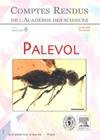阿根廷西北部厚齿兽科(厚齿兽科,Notoungulata)谱系牙齿轮廓的形态间隙检测:记录的系统和古生物地理学意义
IF 1.3
4区 地球科学
Q3 PALEONTOLOGY
引用次数: 2
摘要
在南美洲南部的晚中新世-上新世露头中,厚骨龙亚科(厚骨龙亚科,厚骨龙亚科)是一个非常常见的分支。在阿根廷,有两个属被确认为这个跨度:1891年的Tremacyllus Ameghino和1888年的Paedotherium Burmeister。当为系统目的描述颊齿时,这些新近系形式的简化-真下齿列造成了重大困难。Tremacyllus与Paedotherium的比较研究很少,分类分析将诊断特征解释为种内变异,并提出该属的单特异性地位。考虑到对Tremacyllus物种有效性的讨论,以及牙齿元素是化石记录中最丰富的遗骸,我们采用几何形态计量学和多元统计学提供的定量框架来区分牙齿轮廓的种内和种间变异。我们分析了82个标本的大样本,并检验了两个假设:1)分析样本中存在形态间隙;2)标本形态具有一定的地理变异规律,适合于物种识别。我们发现形态变异分为两类。在P4和上前磨牙数据集中,形态差距与地理格局有关。根据模式标本的分类和支持的集群结构,我们认为Tremacyllus incipiens Rovereto, 1914是阿根廷西北部西部露头区特有的一个有效分类群。南北形态的分离符合两个不同的古植物地理省。事实证明,这种方法对解决种内和种间变异非常有效,并有助于了解评估形态变异的可用技术。本文章由计算机程序翻译,如有差异,请以英文原文为准。
Detecting morphological gaps in tooth outlines of a Pachyrukhinae (Hegetotheriidae, Notoungulata) lineage: systematic and palaeobiogeographical significance of the records from Northwestern Argentina
Pachyrukhinae (Hegetotheriidae, Notoungulata) is a highly frequent clade in the Late Miocene-Pliocene outcrops of southern South America. In Argentina, two genera have been recognized for this span: Tremacyllus Ameghino, 1891 and Paedotherium Burmeister, 1888. The simplified euhypsodont dentition of these Neogene forms creates significant difficulties when cheek teeth are described for systematic purposes. Tremacyllus has been scarcely studied in comparison with Paedotherium, and taxonomic analyses have interpreted diagnostic features as intraspecific variations and proposed the monospecific status of the genus. Given the discussion regarding the validity of Tremacyllus species and the fact that dental elements are the most abundant remains in the fossil record, we employed a quantitative framework provided by geometric morphometrics and multivariate statistics to discriminating intra- from interspecific variability by tooth outline. We analyzed a large sample of 82 specimens and two hypotheses were tested: 1) there are morphological gaps within the analyzed sample; and 2) morphology follows a pattern of geographical variation within the sample, suitable for recognition of species. We found that morphological variability is organized into two clusters. Morphological gaps are associated with geographical patterns in the P4 and upper premolars datasets. Based on the classification of the type specimens and supported cluster structure, we recognize Tremacyllus incipiens Rovereto, 1914 as a valid taxon, endemic from western outcrops of Northwestern Argentina. Segregation between northern and southern morphologies agrees with two different palaeo-phytogeographic provinces. This approach proved to be very effective to address intra- and interspecific variation and contribute to the knowledge of available techniques to assess morphological variation.
求助全文
通过发布文献求助,成功后即可免费获取论文全文。
去求助
来源期刊

Comptes Rendus Palevol
地学-古生物学
CiteScore
2.10
自引率
0.00%
发文量
39
审稿时长
17.6 weeks
期刊介绍:
Comptes Rendus Palevol is a fully electronic and peer-reviewed journal, with a continuous publication stream, devoted to palaeontology, prehistory and evolutionary sciences. It publishes original research results, in French or English, in the following domains: systematic and human palaeontology, prehistory, evolutionary biology and macroevolution, and history of sciences. Thematic issues may also be published under the responsibility of a guest editor. All articles published in Comptes Rendus Palevol are compliant with the different nomenclatural codes. A copyright assignment will be signed by the authors before publication.
 求助内容:
求助内容: 应助结果提醒方式:
应助结果提醒方式:


